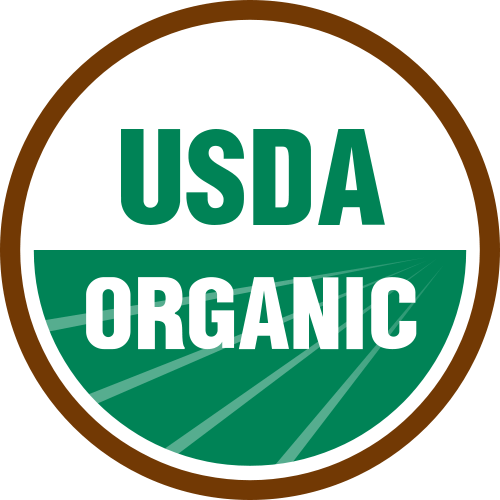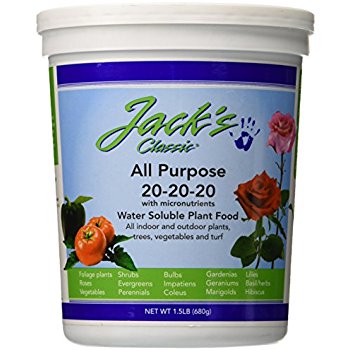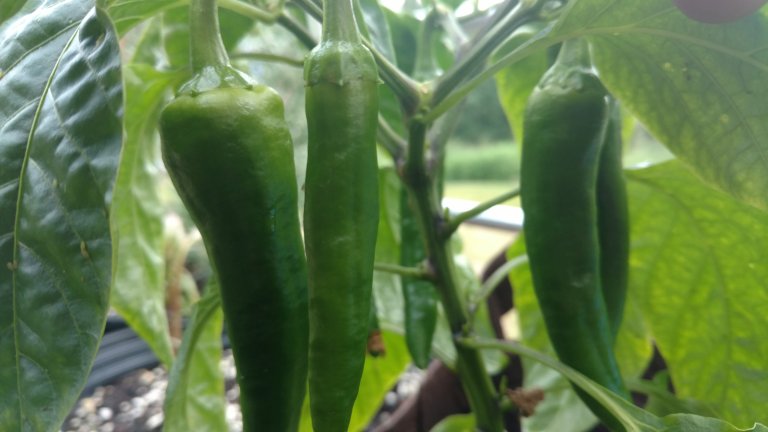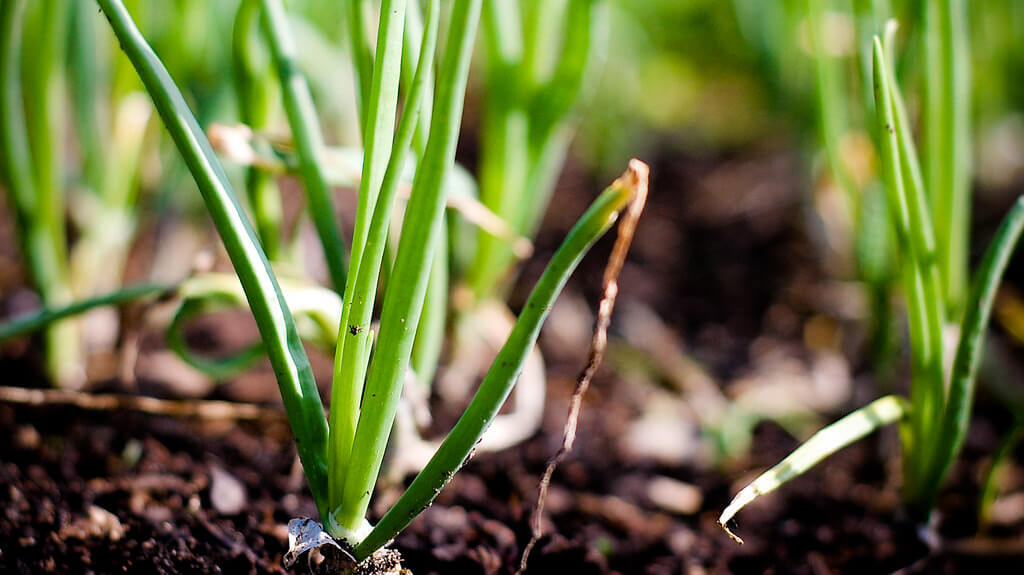In this post, we tackle one of the most “controversial” topics we’ve encountered in gardening. That is, the topic of organic versus non-organic gardening techniques.
This process has been one of the most interesting “learning moments” in our effort to become better gardeners. We think the subject deserves a place on our site!
We Were Like Every Other Organic Gardener!
The term organic means different things to different people. For the purposes of this post, organic gardening essentially means not using synthetically derived fertilizers.

For many of the years that we’ve gardened, we’ve held true to organic techniques. We avoided synthetically derived fertilizers like the plague!
Instead, we heavily relied on things like fish based fertilizers, compost and other organic based plant food.
To us, it just seemed like the right thing to do. Organic certainly “sounded better” and we just did what we thought we should do.
We never really spent long thinking about it, though. That is, until we started gardening in the subarctic!
Turns Out, Subarctic Gardening Is Hard!
When we started gardening in Fairbanks, we really struggled with many of our plants. We just weren’t seeing the growth we wanted to see.
Our plants weren’t quite as large. We weren’t seeing anything close to the yields we knew we could get.
We were, of course, comparing our experience to gardening at lower latitudes.
The cooler summers here really are something to overcome. Growth is slowed. Our soils are cool. Not to mention, our short season is absolutely unforgiving.
Subarctic gardening is slightly beyond average cold climate gardening.
Our struggle went on for a couple of years. We knew we wanted to do better.
We just didn’t know what to do.
Winter Is A Time For Gardening Reflection
Over one winter, in between seasons, a profound thought occurred to me.
Virtually every greenhouse operation that I’ve been familiar with does not use organic fertilizers. There are simply very few all organic, professional growers out there.
I thought about that and realized that if organic fertilizers were truly superior, every greenhouse would be using them.
The decision to be organic is not only about cost. There’s really not a major gap in cost between organic versus non-organic fertilizers.
I thought about the motivation of the professional grower. They want to produce the best quality and most resilient product they can. They want you to come back next year for more.
As I thought about this idea more and more, I thought, “Maybe you’re onto something?” Soon after, “Why aren’t you listening to the professionals?”
Learning About The Magic Of Blue Crystals
There’s a lot of snake oil in the gardening market.
Hundreds of manufacturers are putting out products, many of which don’t work as well as they should. Many of these products are also grossly overpriced.
A consistent theme I’ve seen among professional growers is the application of “blue fertilizer” of various makes and manufacturer. I had even seen bags of these blue crystals for sale at some greenhouses.

As I did more research into these supposed “magic blue crystals,” I consistently came across the name of JR Peters and a product line affectionately referred to as “Jack’s.”
I learned that this company had been at the fertilizer game since 1947. That’s a long time to be selling “snake oil” if that were the case.
What attracted me to JR Peters was the fact that their business model wasn’t just fertilizer. They are primarily a laboratory that does soil analysis.
Farmers from around the U.S. send soil samples to them to have it analyzed for nutritional status. This allows these farmers to make decisions on exactly what to put into their soil to get the results they want.
This company was using science to help farmers produce better food. It seemed reasonable to believe they used that same science to create their fertilizer products.
Getting Over The Hurdle Of What’s Right For Your Plants
As I reviewed JR Peters product line up, I found very specific products for very specific applications.
They had a tomato fertilizer. They had a citrus fertilizer. There wasn’t a “one size fits all” type of approach. They were using common knowledge of different plant’s needs to create products designed for those plants.
I could tell this wasn’t rooted in some mythical attempt to corner some market segment. Those plants, specifically, have unique nutritional needs.
The scientist in me tells me that if a plant can use chemically derived nitrogen, phosphorus, potassium and other micronutrients – then it’s the “real deal” so to speak.
Nitrogen is nitrogen. Potassium is potassium. It doesn’t matter how you get there.
Put another way, a person could choose a diet of nothing but Twinkies and Snickers bars. Technically, such a diet would allow you to subsist and live, but it would be unlikely to allow the person to thrive.
I figured if this stuff wasn’t actually benefitting my plants, I would be able to tell.
So, at this point, I was prepared to give the product a trial run. I was OK with trying this non-organic alternative at least once.
The Proof Is In The Pudding, As They Say
I have zero interest in trying to sell magic blue crystals. I think every gardener should find the right solutions that work for them.
But, I am here to tell you this decision has probably made the biggest difference in plant growth and harvest yields that I have seen since I started gardening many years ago.
We are seeing larger plants, better yields and overall better plant health than I have ever seen in our gardens.
Where we struggled with deficiencies in the past, we haven’t seen any of these problems. Every plant has been super healthy with incredible root structures.
Within two days of fertilizer application, the plants show noticeable difference in growth. It’s been absolutely incredible to see how much better they respond to non-organic fertilizer compared to high doses of fish fertilizer and compost.
As for quality of the produce, honestly, I can’t tell the difference between an organically grown zucchini and a non-organic one. They look the same, smell the same and taste the same.

This is an example of the yields we are seeing. Despite a very cool summer, our poblano pepper plants are maturing out very nicely and yields are higher than we’ve ever seen in the past when using organic fertilizers.
In my mind, if this fertilizer wasn’t legit, this result wouldn’t be possible. Plants work on nitrogen, potassium and phosphorus. You can’t just chemically engineer fake elements and please a plant.
I honestly think that “being the farmer” makes a bigger difference in freshness and produce quality than any difference that could be seen between organic and not.
Science Backs Our Position
One of the more interesting things I learned, after going down the route of non-organic fertilizers, is that there is actual science that backs up our “discovery.”
Boreal soils are simply more anaerobic, meaning there are much lesser quantities of microbes found in northern soils. Those microbes are fully responsible for breaking down of organic matter and allowing it to be turned into micronutrients that plants can actually use.
What this means is that things like compost and organic ingredients will take much longer to become functionally available to the plants.
This isn’t to say that organics “don’t work” in northern soils, but rather that they work less effectively than you’d see in warmer climates.
Using “immediately available” fertilizers allows your plants immediate access to the nutrition they need.
Interestingly, this is also the primary reason that peat is so commonly found in boreal soils. It is more common for soil organic matter to go without composting, which results in peat beneath the soils.
Why Yield Is The Only Thing That Matters
When you think about it, yields make the biggest difference in gardening.
You’re investing six months of time into your garden and that doesn’t change if you have low yields or high yields.
There are very real, fixed costs associated with gardening. Higher yields mean better cost effectiveness of your time and money.
It only makes sense to pursue the greatest yield, and that’s especially true when gardening in the subarctic!
Organic Gardening Still Isn’t A Bad Practice
We mentioned above that organic horticulture, for the purposes of this post, is simply the use of synthetically derived fertilizers. That isn’t all there is to it.

Organic gardening is a multi-faceted approach to gardening. It deals with ideas such as soil management and soil building. Organic also deals with the preservation of heirloom varieties. It deals with natural approaches to pests. It means just saying no to GMO.
We made the above decision solely in regards to soil fertility. But that doesn’t mean we’ve turned our backs to the other principles found in organic gardening.
There is no unwritten rule that says you can’t blend organic and non-organic techniques. We’ve learned to use organic methods when and where it makes sense. Non-organic methods when that makes more sense.
We still consider ourselves “mostly” organic gardeners. All the things that mattered to us before, still matter! We just needed a little bit of help to overcome our growing environment.
In Conclusion…
Gardening has been an interesting journey in learning for me. If anything, I’ve learned to challenge my assumptions more often than not.
There are probably ways a person could be a better all-organic gardener and rival our results. We think that’s a great pursuit!
If you’ve found yourself in a similar position, it might be worth trying out these magic blue crystals. If you’re looking for a way to increase yields and achieve a better garden, this might be something worth trying!
We were surprised by it! We don’t feel like “dirty non-organic growers” either, it was the right decision for us!
That’s All We Wrote!

Having a good time? We have an ever growing list of insightful and helpful subarctic & cold climate gardening articles, waiting out there for you!
- Cold Climate Gardening Basics 👉
- Growing Your Garden From Seed Indoors 👉
- Advanced Cold Climate Gardening Techniques 👉
- Plant Specific Cold Climate Growing Guides 👉
- Subarctic Perennial Food Forests & Foraging 👉
- Indoor Garden Lighting & Grow Rooms 👉
- Greenhouses & Temperature Control 👉
- Harvesting & Food Preservation 👉
- Solving Cold Climate Garden Problems 👉
- 1 Minute Reads On Tons Of Garden Topics 👉
FrostyGarden.com is 100% ad-free and we do not use affiliate links! This resource is voluntarily supported by our readers. (Like YOU!) If we provided you value, would you consider supporting us?

Love this article. I appreciate how thorough you are in explaining your decision. N is nitrogen. I guess it doesn’t matter where you get it, just how it is packaged. Nitrogen compound wise I mean. Thanks
Previously, we always thought there was some sort of difference. But, that’s completely illogical when you think about it! It’s really just the derived source, but it’s all the same when it gets to the plant! Thanks for following our blog, Jeffrey.
Totally agree. I also settled on a blended approach. I add a chemical derived fertilizer and also add slower amendments like bone and blood meal. Summer are too short and plant need to grow with a bang! Love your articles!
Thanks for the feedback, Renée! We like the blended approach too, best of both worlds.
OK, N is N, and P is P, etc. I’ve used Jacks, I know its going to result in excellent growth. And I’ve been trying to wean off it and go organic (opposite direction as you). What is failed to be mentioned here are 2 things: 1) does the plant contain any sort of “unnatural” traces of chemicals your body wouldn’t normally consume, after the plant consumes non-organic food? 2) what effect does this have on the soil? Dumping tons of chemicals into it over time that the plant doesn’t take up?
Right now there is a huge movement for “Soil Regeneration”. It has become inert for more reasons than just pesticides. What role does non-organic fertilizer play? These are genuine questions.
Great comment! Thanks! As for unnatural traces, I would at least hope that fert manufacturers take care not to have them to begin with. (The MSDS for Jacks basically says “dispose of as a fertilizer in a field.”) I do agree that over concentration of certain chemicals is a bad thing. That’s just as prevalent with non-organic approaches, too. If I had the means, I’d test my soil and treat it specifically for particular insufficiencies, but that’s hard to do at the home garden scale. (Many larger scale farmers do this, actually.)
As for your second comment, I do think in the “long run” that additions like compost and other organics benefit the soil. We actually practice this, as well as non-organic approaches as both are important. But, they do almost serve different purposes – long term soil health vs. instant satisfaction.
Thanks for your comments Jeff!! I too have been a “blended” fertilizer gardener for many many years!! Our soils are just too cold and growing season too short for anything but blended gardening!! I also have composting worms that I overwinter in my garage and add to my gardens…works fantastic!! Thanks for sharing an alternative perspective to fertilizing in the sub-arctic!!
Thanks for the comment, Deborah! Worm castings are definitely great! Glad you found the perspective helpful.